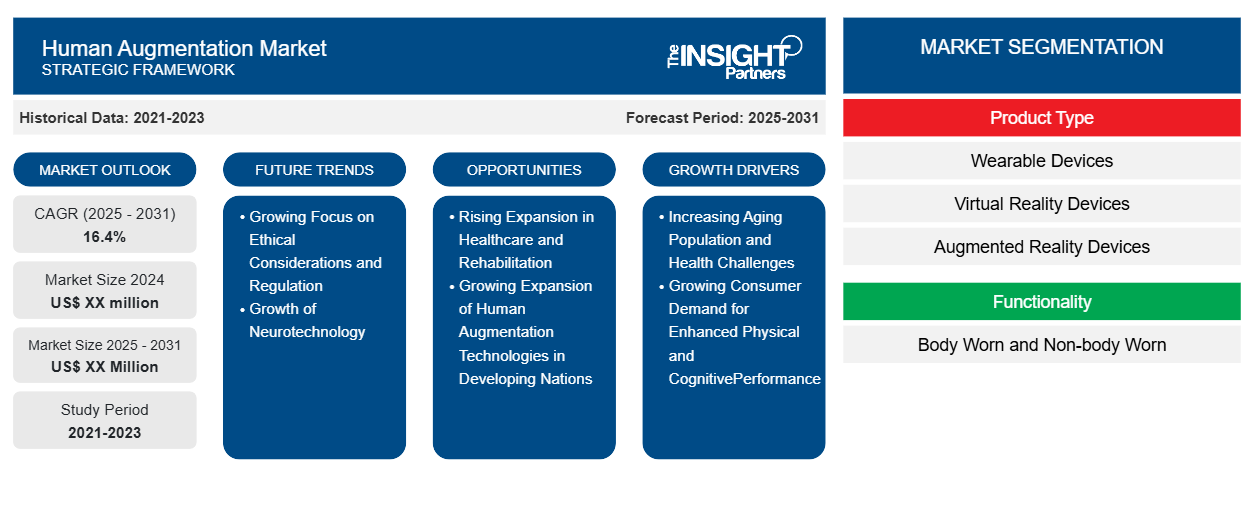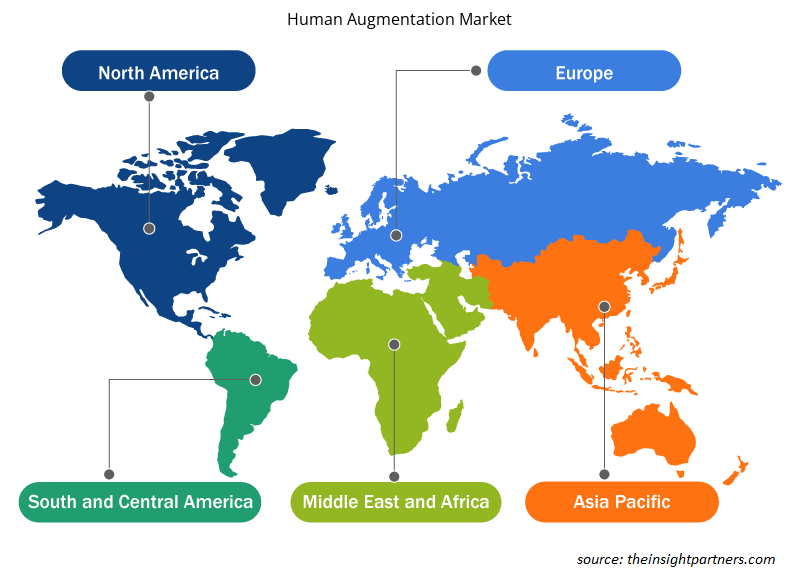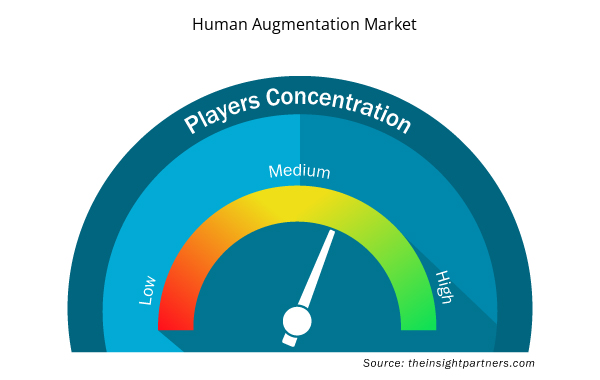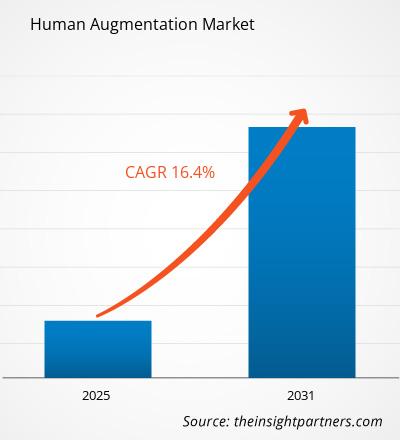Für den Markt für Human Augmentation wird von 2025 bis 2031 eine durchschnittliche jährliche Wachstumsrate (CAGR) von 16,4 % erwartet, wobei die Marktgröße von XX Millionen US-Dollar im Jahr 2024 auf XX Millionen US-Dollar im Jahr 2031 anwachsen wird.
Der Bericht ist segmentiert nach Produkttyp (tragbare Geräte, Virtual-Reality-Geräte, Augmented-Reality-Geräte, Exoskelette und intelligente virtuelle Assistenten), Funktionalität (körpergetragen und nicht am Körper getragen) und Anwendung (Verbraucher, Gewerbe, Gesundheitswesen, Luft- und Raumfahrt und Verteidigung, Energie und Versorgung und Sonstige). Die globale Analyse wird weiter nach Regionen und wichtigen Ländern aufgeschlüsselt. Der Bericht bietet den Wert in USD für die oben genannten Analysen und Segmente.
Zweck des Berichts
Der Bericht „Human Augmentation Market“ von The Insight Partners beschreibt die aktuelle Marktsituation und das zukünftige Wachstum sowie die wichtigsten Treiber, Herausforderungen und Chancen. Er liefert Einblicke für verschiedene Geschäftsinteressenten, wie zum Beispiel:
- Technologieanbieter/-hersteller: Um die sich entwickelnde Marktdynamik zu verstehen und die potenziellen Wachstumschancen zu kennen, können sie fundierte strategische Entscheidungen treffen.
- Investoren: Um eine umfassende Trendanalyse hinsichtlich der Marktwachstumsrate, der finanziellen Marktprognosen und der Chancen entlang der Wertschöpfungskette durchzuführen.
- Regulierungsbehörden: Sie regulieren die Richtlinien und polizeilichen Aktivitäten auf dem Markt mit dem Ziel, Missbrauch zu minimieren, das Vertrauen der Anleger zu wahren und die Integrität und Stabilität des Marktes aufrechtzuerhalten.
Marktsegmentierung für menschliche Augmentation
Produkttyp
- Tragbare Geräte
- Virtual-Reality-Geräte
- Augmented Reality-Geräte
- Exoskelett
- Intelligente virtuelle Assistenten
Funktionalität
- Am Körper getragen und nicht am Körper getragen
Anwendung
- Verbraucher
- Kommerziell
- Gesundheitspflege
- Luft- und Raumfahrt und Verteidigung
- Energie und Versorgung
- Sonstiges
Geographie
- Nordamerika
- Europa
- Asien-Pazifik
- Süd- und Mittelamerika
- Naher Osten und Afrika
Passen Sie diesen Bericht Ihren Anforderungen an
Sie erhalten kostenlos Anpassungen an jedem Bericht, einschließlich Teilen dieses Berichts oder einer Länderanalyse, eines Excel-Datenpakets sowie tolle Angebote und Rabatte für Start-ups und Universitäten.
Markt für menschliche Augmentation: Strategische Einblicke

- Informieren Sie sich über die wichtigsten Markttrends in diesem Bericht.Dieses KOSTENLOSE Beispiel umfasst eine Datenanalyse, die von Markttrends bis hin zu Schätzungen und Prognosen reicht.
Wachstumstreiber des Marktes für menschliche Augmentation
- Zunehmende Alterung der Bevölkerung und gesundheitliche Herausforderungen: Die weltweit zunehmende Alterung der Bevölkerung ist ein wichtiger Treiber für den Markt für Human Augmentation. Mit zunehmendem Alter stehen Menschen oft vor verschiedenen gesundheitlichen Herausforderungen, die ihre Mobilität und Lebensqualität beeinträchtigen können. Human Augmentation-Technologien wie Prothesen und Mobilitätshilfen können die Unabhängigkeit und das Wohlbefinden älterer Menschen deutlich verbessern. Da zudem die Prävalenz chronischer Krankheiten zunimmt, wird die Nachfrage nach Lösungen zur Verbesserung der körperlichen Leistungsfähigkeit und zur Unterstützung der Rehabilitation voraussichtlich steigen und den Markt weiter vorantreiben.
- Steigende Verbrauchernachfrage nach verbesserter körperlicher und kognitiver Leistungsfähigkeit: Die Nachfrage nach Produkten zur Verbesserung der körperlichen und kognitiven Leistungsfähigkeit steigt. Dies ist auf eine Kultur zurückzuführen, die persönliche Produktivität und Effizienz zunehmend schätzt. Von Sportlern, die leistungssteigernde Ausrüstung suchen, bis hin zu Profis, die kognitive Leistungssteigerungen anstreben – der Markt für menschliche Augmentation wächst. Diese Nachfrage hat zu Innovationen bei tragbarer Technologie, intelligenten Geräten und sogar Produkten zur Neuroverbesserung geführt, die versprechen, verschiedene Aspekte menschlicher Fähigkeiten zu verbessern. Da Verbraucher weiterhin nach Möglichkeiten zur Leistungsoptimierung suchen, wird der Markt für menschliche Augmentation weiter florieren.
Zukünftige Trends auf dem Markt für menschliche Augmentation
- Wachsender Fokus auf ethische Überlegungen und Regulierung: Mit dem Wachstum des Marktes für menschliche Augmentation rücken ethische Überlegungen und Regulierungen im Zusammenhang mit diesen Technologien zunehmend in den Fokus. Bedenken hinsichtlich Gerechtigkeit, Datenschutz und potenziellem Missbrauch von Augmentationstechnologien führen zu Diskussionen unter Beteiligten, darunter Politikern, Technikern und Ethikern. Dieser Trend führt zur Entwicklung von Richtlinien und Rahmenbedingungen, die Innovation und ethische Praktiken in Einklang bringen sollen. Unternehmen, die ethische Entwicklung und Transparenz priorisieren, können sich in einem Markt, der verantwortungsvolle Innovation schätzt, einen Wettbewerbsvorteil verschaffen.
- Wachstum der Neurotechnologie: Der Bereich Neurotechnologie entwickelt sich rasant und entwickelt sich zu einem bedeutenden Trend im Markt für Human Augmentation. Technologien, die direkt mit dem Nervensystem interagieren, wie beispielsweise Brain-Computer-Interfaces (BCIs), gewinnen aufgrund ihres Potenzials, kognitive Fähigkeiten zu verbessern und verlorene Funktionen wiederherzustellen, zunehmend an Bedeutung. Die Anwendungsgebiete reichen von der Unterstützung von Menschen mit Behinderungen bis hin zur Verbesserung der geistigen Leistungsfähigkeit gesunder Menschen. Mit fortschreitender Forschung und Entwicklung in der Neurotechnologie werden voraussichtlich weitere Anwendungen entstehen, die neue Wachstumschancen in diesem Sektor eröffnen.
Marktchancen für Human Augmentation
- Steigendes Wachstum im Gesundheitswesen und in der Rehabilitation: Der Markt für Human Augmentation bietet erhebliche Chancen im Gesundheits- und Rehabilitationssektor. Mobilitätsfördernde Technologien wie robotische Exoskelette und fortschrittliche Prothesen können die Behandlungsergebnisse und die Lebensqualität der Patienten deutlich verbessern. Darüber hinaus können Innovationen in der kognitiven Augmentation die Rehabilitation von Schlaganfallpatienten oder Menschen mit Hirnverletzungen unterstützen. Da Gesundheitssysteme zunehmend personalisierte und technologiebasierte Behandlungsansätze verfolgen, dürfte die Nachfrage nach Human Augmentation-Lösungen in diesen Bereichen steigen.
- Wachsende Verbreitung von Technologien zur menschlichen Augmentation in Entwicklungsländern: In Schwellenländern bieten sich wachsende Chancen für Technologien zur menschlichen Augmentation, da steigende verfügbare Einkommen und Urbanisierung die Nachfrage nach fortschrittlichen Lösungen ankurbeln. Mit der Entwicklung dieser Regionen steigt der Bedarf an Technologien zur Produktivitätssteigerung und zur Bewältigung gesundheitlicher Herausforderungen. Zudem sind jüngere Bevölkerungsgruppen in diesen Märkten offener für innovative Technologien und schaffen so ein günstiges Umfeld für Produkte zur menschlichen Augmentation. Unternehmen, die sich in diesen Schwellenländern strategisch positionieren, können erheblich profitieren.
Regionale Einblicke in den Markt für menschliche Augmentation
Die Analysten von Insight Partners haben die regionalen Trends und Faktoren, die den Markt für Human Augmentation im Prognosezeitraum beeinflussen, ausführlich erläutert. In diesem Abschnitt werden auch die Marktsegmente und die geografische Lage in Nordamerika, Europa, Asien-Pazifik, dem Nahen Osten und Afrika sowie Süd- und Mittelamerika erörtert.

- Erhalten Sie regionale Daten zum Markt für menschliche Augmentation
Umfang des Marktberichts zur menschlichen Augmentation
| Berichtsattribut | Details |
|---|---|
| Marktgröße im Jahr 2024 | XX Millionen US-Dollar |
| Marktgröße bis 2031 | XX Millionen US-Dollar |
| Globale CAGR (2025 – 2031) | 16,4 % |
| Historische Daten | 2021-2023 |
| Prognosezeitraum | 2025–2031 |
| Abgedeckte Segmente | Nach Produkttyp
|
| Abgedeckte Regionen und Länder | Nordamerika
|
| Marktführer und wichtige Unternehmensprofile |
|
Marktteilnehmerdichte im Bereich Human Augmentation: Auswirkungen auf die Geschäftsdynamik
Der Markt für Human Augmentation wächst rasant. Die steigende Nachfrage der Endnutzer ist auf Faktoren wie veränderte Verbraucherpräferenzen, technologische Fortschritte und ein stärkeres Bewusstsein für die Produktvorteile zurückzuführen. Mit der steigenden Nachfrage erweitern Unternehmen ihr Angebot, entwickeln Innovationen, um den Bedürfnissen der Verbraucher gerecht zu werden, und nutzen neue Trends, was das Marktwachstum weiter ankurbelt.
Die Marktteilnehmerdichte beschreibt die Verteilung der in einem bestimmten Markt oder einer bestimmten Branche tätigen Unternehmen. Sie gibt an, wie viele Wettbewerber (Marktteilnehmer) in einem bestimmten Marktraum im Verhältnis zu dessen Größe oder Gesamtmarktwert präsent sind.
Die wichtigsten Unternehmen, die auf dem Markt für menschliche Augmentation tätig sind, sind:
- Google Inc.
- Samsung Electronics Co. Ltd.
- Ekso Bionics Holdings, Inc.
- Vuzix Corporation
- Garmin
Haftungsausschluss : Die oben aufgeführten Unternehmen sind nicht in einer bestimmten Reihenfolge aufgeführt.

- Verschaffen Sie sich einen Überblick über die wichtigsten Akteure auf dem Markt für Human Augmentation
Wichtige Verkaufsargumente
- Umfassende Abdeckung: Der Bericht deckt die Analyse von Produkten, Dienstleistungen, Typen und Endbenutzern des Marktes für menschliche Augmentation umfassend ab und bietet eine ganzheitliche Landschaft.
- Expertenanalyse: Der Bericht basiert auf dem umfassenden Verständnis von Branchenexperten und Analysten.
- Aktuelle Informationen: Der Bericht gewährleistet Geschäftsrelevanz durch die Berichterstattung über aktuelle Informationen und Datentrends.
- Anpassungsoptionen: Dieser Bericht kann angepasst werden, um den spezifischen Kundenanforderungen gerecht zu werden und die Geschäftsstrategien optimal anzupassen.
Der Forschungsbericht zum Markt für Human Augmentation kann daher dazu beitragen, die Branchensituation und die Wachstumsaussichten zu entschlüsseln und zu verstehen. Obwohl es einige berechtigte Bedenken gibt, überwiegen die Vorteile dieses Berichts tendenziell die Nachteile.
- Historische Analyse (2 Jahre), Basisjahr, Prognose (7 Jahre) mit CAGR
- PEST- und SWOT-Analyse
- Marktgröße Wert/Volumen – Global, Regional, Land
- Branche und Wettbewerbsumfeld
- Excel-Datensatz



Report Coverage
Revenue forecast, Company Analysis, Industry landscape, Growth factors, and Trends

Segment Covered
This text is related
to segments covered.

Regional Scope
North America, Europe, Asia Pacific, Middle East & Africa, South & Central America

Country Scope
This text is related
to country scope.
Häufig gestellte Fragen
Some of the customization options available based on the request are an additional 3-5 company profiles and country-specific analysis of 3-5 countries of your choice. Customizations are to be requested/discussed before making final order confirmation# as our team would review the same and check the feasibility
The report can be delivered in PDF/PPT format; we can also share excel dataset based on the request
The Military and Defense Applications is anticipated to play a significant role in the global Human Augmentation market in the coming years
The major factors driving the Human Augmentation market are Advancements in Wearable Technology and Growing Healthcare and Medical Applications.
The Human Augmentation Market is estimated to witness a CAGR of 16.4% from 2023 to 2031
-
Trends and growth analysis reports related to Electronics and Semiconductor : READ MORE..
The List of Companies
1. Google Inc.
2. Samsung Electronics Co. Ltd.
3. Ekso Bionics Holdings, Inc.
4. Vuzix Corporation
5. Garmin
6. Fossil Group, Inc.
7. B-Temia Inc.
8. Casio
9. Magic Leap Inc.
10. Rewalk Robotics Ltd.
The Insight Partners performs research in 4 major stages: Data Collection & Secondary Research, Primary Research, Data Analysis and Data Triangulation & Final Review.
- Data Collection and Secondary Research:
As a market research and consulting firm operating from a decade, we have published and advised several client across the globe. First step for any study will start with an assessment of currently available data and insights from existing reports. Further, historical and current market information is collected from Investor Presentations, Annual Reports, SEC Filings, etc., and other information related to company’s performance and market positioning are gathered from Paid Databases (Factiva, Hoovers, and Reuters) and various other publications available in public domain.
Several associations trade associates, technical forums, institutes, societies and organization are accessed to gain technical as well as market related insights through their publications such as research papers, blogs and press releases related to the studies are referred to get cues about the market. Further, white papers, journals, magazines, and other news articles published in last 3 years are scrutinized and analyzed to understand the current market trends.
- Primary Research:
The primarily interview analysis comprise of data obtained from industry participants interview and answers to survey questions gathered by in-house primary team.
For primary research, interviews are conducted with industry experts/CEOs/Marketing Managers/VPs/Subject Matter Experts from both demand and supply side to get a 360-degree view of the market. The primary team conducts several interviews based on the complexity of the markets to understand the various market trends and dynamics which makes research more credible and precise.
A typical research interview fulfils the following functions:
- Provides first-hand information on the market size, market trends, growth trends, competitive landscape, and outlook
- Validates and strengthens in-house secondary research findings
- Develops the analysis team’s expertise and market understanding
Primary research involves email interactions and telephone interviews for each market, category, segment, and sub-segment across geographies. The participants who typically take part in such a process include, but are not limited to:
- Industry participants: VPs, business development managers, market intelligence managers and national sales managers
- Outside experts: Valuation experts, research analysts and key opinion leaders specializing in the electronics and semiconductor industry.
Below is the breakup of our primary respondents by company, designation, and region:

Once we receive the confirmation from primary research sources or primary respondents, we finalize the base year market estimation and forecast the data as per the macroeconomic and microeconomic factors assessed during data collection.
- Data Analysis:
Once data is validated through both secondary as well as primary respondents, we finalize the market estimations by hypothesis formulation and factor analysis at regional and country level.
- Macro-Economic Factor Analysis:
We analyse macroeconomic indicators such the gross domestic product (GDP), increase in the demand for goods and services across industries, technological advancement, regional economic growth, governmental policies, the influence of COVID-19, PEST analysis, and other aspects. This analysis aids in setting benchmarks for various nations/regions and approximating market splits. Additionally, the general trend of the aforementioned components aid in determining the market's development possibilities.
- Country Level Data:
Various factors that are especially aligned to the country are taken into account to determine the market size for a certain area and country, including the presence of vendors, such as headquarters and offices, the country's GDP, demand patterns, and industry growth. To comprehend the market dynamics for the nation, a number of growth variables, inhibitors, application areas, and current market trends are researched. The aforementioned elements aid in determining the country's overall market's growth potential.
- Company Profile:
The “Table of Contents” is formulated by listing and analyzing more than 25 - 30 companies operating in the market ecosystem across geographies. However, we profile only 10 companies as a standard practice in our syndicate reports. These 10 companies comprise leading, emerging, and regional players. Nonetheless, our analysis is not restricted to the 10 listed companies, we also analyze other companies present in the market to develop a holistic view and understand the prevailing trends. The “Company Profiles” section in the report covers key facts, business description, products & services, financial information, SWOT analysis, and key developments. The financial information presented is extracted from the annual reports and official documents of the publicly listed companies. Upon collecting the information for the sections of respective companies, we verify them via various primary sources and then compile the data in respective company profiles. The company level information helps us in deriving the base number as well as in forecasting the market size.
- Developing Base Number:
Aggregation of sales statistics (2020-2022) and macro-economic factor, and other secondary and primary research insights are utilized to arrive at base number and related market shares for 2022. The data gaps are identified in this step and relevant market data is analyzed, collected from paid primary interviews or databases. On finalizing the base year market size, forecasts are developed on the basis of macro-economic, industry and market growth factors and company level analysis.
- Data Triangulation and Final Review:
The market findings and base year market size calculations are validated from supply as well as demand side. Demand side validations are based on macro-economic factor analysis and benchmarks for respective regions and countries. In case of supply side validations, revenues of major companies are estimated (in case not available) based on industry benchmark, approximate number of employees, product portfolio, and primary interviews revenues are gathered. Further revenue from target product/service segment is assessed to avoid overshooting of market statistics. In case of heavy deviations between supply and demand side values, all thes steps are repeated to achieve synchronization.
We follow an iterative model, wherein we share our research findings with Subject Matter Experts (SME’s) and Key Opinion Leaders (KOLs) until consensus view of the market is not formulated – this model negates any drastic deviation in the opinions of experts. Only validated and universally acceptable research findings are quoted in our reports.
We have important check points that we use to validate our research findings – which we call – data triangulation, where we validate the information, we generate from secondary sources with primary interviews and then we re-validate with our internal data bases and Subject matter experts. This comprehensive model enables us to deliver high quality, reliable data in shortest possible time.

 Holen Sie sich ein kostenloses Muster für diesen Bericht
Holen Sie sich ein kostenloses Muster für diesen Bericht